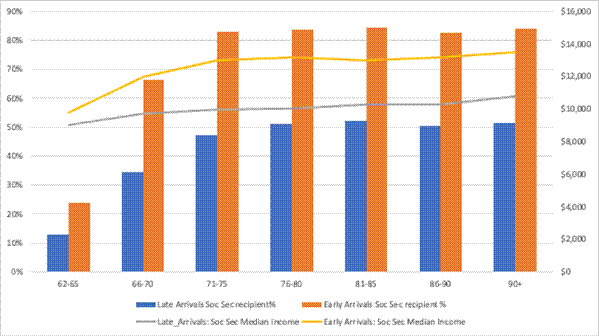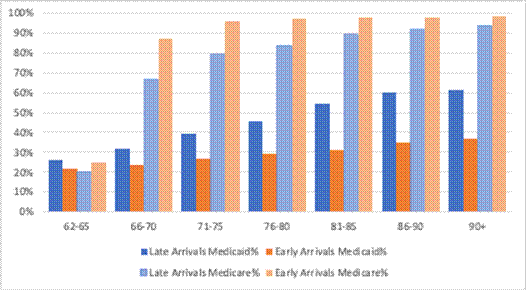Abstract
Late-arriving immigrants constitute the largest segment (49%) of Social Security “never beneficiaries,” lacking adequate earnings to qualify for benefits. Many such immigrants work into their older years, due to financial constraints and the pursuit of Social Security eligibility. Using the most recent microdata from the American Community Survey and the Survey of Income and Program Participation linked to Social Security administrative earnings and beneficiary records, our study assesses a group difficult to study through smaller sample surveys, exploring how arriving in the United States at older ages shapes older immigrants’ retirement security, including employment opportunities, Social Security income, other income, and public health insurance access.
Key Words
late arriving immigrants, retirement security, Social Security and Medicare eligibility, work, income, health insurance coverage
Social Security and Medicare are essential for the economic and health security of older adults, but many immigrants, especially those who come to the United States later in life, struggle to access these benefits. Late-arriving immigrants often face real challenges finding formal employment due to age, language barriers, or difficulties transferring their skills and work experience. Without enough years of work in the United States, they can’t qualify for Social Security or Medicare, even though they need them most.
Immigrants tend to retire and claim benefits later than U.S.-born individuals (Lopez & Slavov, 2020). Older immigrants are more likely to have lower income, lower rates of Social Security and Medicare participation, inadequate retirement savings, higher poverty rates, and increased reliance on Supplemental Security Income (SSI) and Medicaid (Gray et al., 2006; O’Neil & Tienda, 2015; Sevak & Schmidt, 2014).
Yet researchers and policymakers have largely overlooked one key factor: age at migration. Many immigrants arrive in later life to reunite with family or to escape difficult conditions in their home countries. Immigrants arriving later in life risk being left out of the social safety net. This study reveals how late-arriving immigrants—a group often overlooked—face steep barriers not only to finding work but also to accessing the programs designed to ensure financial and health stability in later life.
Many late-arriving immigrants continue working into older age, primarily out of economic necessity and to qualify for Social Security benefits (Åslund et al., 2024; Borjas, 2011). However, a significant portion of late-arriving immigrants never receive Social Security benefits due to an insufficient work history under the U.S. system, even though they worked all of their lives (Whitman et al., 2011). While certain countries have totalization agreements with the United States to coordinate and transfer Social Security contributions, many ethnic immigrant groups, notably most Asian and Latino immigrants, are not covered by these agreements for political reasons. As a result, upon their arrival in the United States, migrants from nations without totalization agreements must rebuild their work history and Social Security eligibility from scratch, racing against time as they age.
The Immigration and Nationality Act of 1965 transformed U.S. immigration patterns, leading to more demographic diversity fueled by migration from Latin America, Asia, and other non-European regions (Alba, 2020; Alba & Nee, 2003). Unlike earlier waves dominated by European migrants who followed relatively straightforward pathways to assimilation, post-1965 immigrant cohorts face varied and complex trajectories shaped by factors such as ethnicity, race, country of origin, and socioeconomic backgrounds (Alba & Foner, 2015; Portes & Zhou, 1993).
Late arriving immigrants fill critical labor shortages, especially in low-wage, physically demanding jobs that are difficult to staff.
Over the past 2 decades, an increasing number of individuals have been migrating to the United States in their 50s or older. According to the Current Population Survey, among the two largest older immigrant groups, the number of Asian immigrants arriving in their 50s more than doubled from 1.3 million in 1994 to 2.9 million in 2019. Similarly, Hispanic immigrants in this age group increased from 484,000 to 1.2 million over the same period.
Late-arriving immigrants often face barriers such as limited English proficiency, cultural differences, and age discrimination that keep them out of the formal labor market. Some of them find work in ethnic enclave economies, where immigrant networks provide job opportunities and community support (Portes & Manning, 1986; Sanders & Nee, 1987). These workers fill critical labor shortages, especially in low-wage, physically demanding jobs that are difficult to staff. Yet despite their contributions, many are excluded from key benefit programs due to the lack of a totalization agreement between the United States and their countries of origin. Older migrants also are routinely left out of policy discussions on retirement security and aging support.
(The United States has Social Security “totalization” agreements with 30 countries, so workers get credit for work across borders. Totalization allows workers’ contributions from both countries to count toward their eligibility; current partner countries include many European nations and selected political partners. Note that nations from which large numbers of Americans come—China, India, Mexico—are not on the list. Included nations are Australia, Austria, Belgium, Brazil, Canada, Chile, the Czech Republic, Denmark, Finland, France, Germany, Greece, Hungary, Iceland, Ireland, Italy, Japan, Luxembourg, the Netherlands, Norway, Poland, Portugal, the Slovak Republic, Slovenia, South Korea, Spain, Sweden, Switzerland, the United Kingdom, and Uruguay (Social Security, n.d.).
This article explores various aspects of the economic situation, employment status, Social Security eligibility, and health insurance coverage among late-arriving immigrants using the most recent 5-year sample of the American Community Survey (ACS, U.S. Census Bureau, 2019–2023) and the Survey of Income and Program Participation (SIPP) Beta data (U.S. Census Bureau, 1951–2014) linked to Social Security administrative records on lifetime earnings and beneficiary information. Understanding the retirement strategies and economic hardships of this frequently overlooked group is important for policymakers striving to improve the well-being of older adults and reduce old-age poverty.
Our research, originally funded by the Social Security Administration, included plans to interview late-arriving immigrants about their economic strategies and lived experiences. However, a stop-work order in February 2025 ended the funding before the interviews could take place. Despite this, the quantitative data reveal significant hardship among this group and offer valuable insights to inform more effective policy design.
Late-arriving Immigrants’ Economic Well-being
Social Security Participation
We look at Social Security participation and median income by age and nativity for three groups: immigrants who came at age 50 or older (“late arrivals”), immigrants who arrived before age 50 (“early arrivals”), and people born in the United States. Late-arriving immigrants have the lowest Social Security participation and income. Just 13% receive benefits at ages 62–65, rising to just above 50% by age 76, with a median annual income between $9,000 and $10,805. Earlier arriving immigrants fare better, with 24% receiving benefits at ages 62–65 and more than 80% by age 71; their income rises from about $9,800 to more than $12,979 in their 70s. Individuals born in the United States also show strong participation, with 36% receiving benefits by ages 62–65 and more than 90% by age 71. Their median income begins at $13,400, peaks at $18,000 in their early 70s, and remains above $16,200 in later years. These patterns reflect how age at arrival and time in the United States shapes access to and outcomes from Social Security.
Figure 1. Immigration Timing Matters: Late Arrivals Receive Less in Social Security Benefits

Note: Authors’ calculation using data from the American Community Survey (2019–2023, 5-year data).
Accumulation of Social Security Work Credits
We investigate to what extent low participation in Social Security among late-arriving immigrants is related to insufficient work history, using SIPP Beta data from 1951–2014, linked to Social Security records (results using the SIPP Beta data were reviewed and approved for disclosure [disclosure approval number CBDRB-FY25-0374]). The weighted data represent the U.S. non-institutionalized population for the relevant panel year.
Findings indicate that immigrants who arrived at ages 50 or older had, on average, only 19 quarters of covered work by ages 55 or older, far below the 40 quarters required for eligibility. In contrast, earlier arriving immigrants had 94 quarters, and U.S.-born individuals had around 117.
Late-arriving immigrants become eligible for benefits based solely upon work credits much later, at age 66 on average, compared to those who arrived earlier (age 39) or were born in the United States (age 34). Only 69% of late-arriving immigrants receive Social Security retirement benefits based on their employment record by age 65 (compared with 94% of their earlier arriving peers and 96% of U.S.-born counterparts). And by age 70, 8% of late-arriving immigrants still have not received Social Security retirement benefits, whereas virtually all others in the same age range have begun receiving their benefits.
Even when late-arriving immigrants receive Social Security retirement benefits based on their earning record, the monthly benefit amounts are substantially smaller than what early arriving immigrants and U.S.-born retirees receive. The median retirement benefit received by late-arriving immigrants based on their own earning record is $538 per month, compared with $932 for early arriving immigrants and $1,098 for U.S.-born retirees (results using the SIPP Beta data were reviewed and approved for disclosure [disclosure approval number CBDRB-FY25-0374]). These findings highlight a critical gap in retirement security for this group.
Predictors of Successful Accumulation of Social Security Work Credits
Our analysis using the SIPP Beta data identifies predictors of successfully accumulating Social Security credits for late-arriving immigrants. Results indicate that having some college education increases the number of accumulated Social Security credits by 14.9 compared to having less than high school education. Another predictor of accumulating more Social Security credits is the person’s occupation. Those working in the computer and mathematics, architecture and engineering, life, physical, and social science fields accumulated 35.4 additional credits relative to workers in management occupations, followed by those in protective service (33), workers in installation, maintenance and repair occupations (30), production occupations (26), and food prep occupations (18).
‘Education appears to offer fewer employment advantages for late arrivals; unlike early arrivers, higher educational attainment does not significantly improve their likelihood of remaining employed.’
Of course, these disparities may be partly due to occupational sorting, as immigrants often face limited employment options. Age upon arrival to the country reduces Social Security credit accumulation by 12.6 credits among those who arrived at ages 61 or older, so the negative impact of arriving late to the country worsens as one’s age increases. This analysis suggests that higher education and certain occupations among late-arriving immigrants are linked to greater accumulation of Social Security credits toward benefit eligibility. However, assessing whether educated immigrants experience underemployment or negative occupational sorting would require a more sophisticated study design, potentially involving longitudinal panel data.
Supplemental Security Income Receipt
Receipt of Supplemental Security Income (SSI) also varies by nativity and age. Late-arriving immigrants rely increasingly upon SSI as they age, from less than 3% at ages 62–65 to more than 33% by age 90, though their median annual benefit stays between $7,200 and $9,004. Earlier arriving immigrants have higher SSI use than U.S.-born individuals but lower than late arrivers, peaking at 14.1% in their late 80s. Their median SSI income ranges from about $6,800 to $9,000. U.S.-born individuals show the lowest SSI participation, mostly between 3.5% and 4.9%, but receive the highest average payments, starting at $9,892 and staying above $8,500 across all ages. These patterns show that late-arriving immigrants turn to SSI more often in old age, while U.S.-born individuals rely on it less but receive more generous benefits. Earlier-arriving immigrants generally fall in between.
Figure 2. Late Arrivals Receive Less in SSI Income Than Early Arrivals

Note: Authors’ calculation using data from the American Community Survey (2019–2023, 5-year data).
Own Business Income
Given that older immigrants, particularly late arrivals, often face barriers to employment related to language, work experience, and cultural differences, we examine their entrepreneurship patterns using available data on business income (specifically income from “own business, professional practice, partnership, or farm”) from the ACS. Business income declines with age among immigrants. However, early arriving immigrants are more likely to report business income and receive greater amounts when they do. Among late arrivals, the likelihood of having business income is 5.19% at ages 62–65, with a median income between $10,500 and $15,000. Early arrivals are more likely to have income from their own business (8.06%) at those ages and also a higher median income, ranging from $18,014 to $20,900.
Employment
Employment declines with age for early- and late-arriving immigrants, but those who migrate to the United States later in life are less likely to remain employed at older ages, likely due to barriers such as language challenges and age discrimination. Among adults ages 62–65, 57% of early arrivers are employed, compared to just 44% of late arrivers. This gap persists into later years, with employment rates falling to 34% vs. 27% at ages 66–70, and 17% vs. 14% at ages 71–75. Further analysis shows that employment disparities are influenced by gender, race, and education. Specifically, the employment gaps between Black and Hispanic individuals compared to white individuals, and between women and men, are larger among late-arriving immigrants than among early arrivals. Also, education appears to offer fewer employment advantages for late arrivals; unlike early arrivers, higher educational attainment does not significantly improve their likelihood of remaining employed.
Medicare and Medicaid Coverage
Reliable health insurance and steady income in old age are both essential pillars of economic and health well-being for older adults. Older immigrants face challenges in accessing the two major public health insurance programs. Medicare requires a sufficient work history in the United States, while Medicaid often has state-level residency requirements that can limit eligibility.
Most people become eligible for Medicare at age 65 based upon their work history or their spouse’s, typically requiring 40 work credits or 10 years of covered U.S. employment. Many late arrivers do not meet the work credit requirement when they reach age 65, as discussed earlier, and must either pay full premiums or go without coverage. Among earlier arriving immigrants, participation reaches more than 87% by ages 66–70 and exceeds 97% by age 76. Late arrivers see steady increases as well, reaching 94% by age 90, though they lag behind earlier arrivers at every stage.
Even with SSI and Medicaid, late-arriving immigrants remain more likely to live in poverty compared to early arriving immigrants with similar demographic characteristics.
For many immigrants, especially late arrivals, gaps in coverage arise from ineligibility for premium-free Part A (hospital insurance) and difficulty affording the premiums for Part B (outpatient/medical insurance) or Part D (prescription drugs). As a result, even though Medicare participation rises with age, full coverage may remain out of reach for some older immigrants, particularly those who immigrated later in life and had limited time and opportunity to participate in the U.S. workforce to build eligibility for the program.
Many older immigrants rely on means-tested health insurance programs such as Medicaid, especially if they don’t have enough work history to qualify for full Medicare coverage and meet the low-income and asset thresholds. In the data, Medicaid coverage rises with age for all groups, but it’s more common among late-arriving immigrants. For them, enrollment grows from 26.4% at ages 62–65 to more than 61% by age 90 and older. Early arrivers also see a steady increase in Medicaid enrollment with age, from 21.5% to 36.6%, though their rates remain well below those of late arrivals.
Figure 3. Late Arrivals Are More Likely to Enroll in Medicaid but Less Likely to Enroll in Medicare than Early Arrivals

Note: Authors’ calculation using data from the American Community Survey (2019–2023, 5-year data).
Discussion and Conclusion
Public programs like Social Security and Medicare, for which Americans earn eligibility through work history, play a crucial role in supporting economic security and access to healthcare after retirement. But many late-arriving immigrants fall through the cracks. Because they come to the United States later in life, often they lack the time needed to accumulate sufficient work credits to qualify for these benefits, or they qualify much later in life. This limits the duration of benefit receipt and, in the case of Social Security, may reduce the benefit amount.
As a result, many late arrivals instead qualify for and rely upon means-tested programs such as Supplemental Security Income (SSI) and Medicaid. Yet even with these supports, they remain more likely to live in poverty compared to early arriving immigrants with similar demographic characteristics. Poverty rates are especially high among immigrants from countries without a totalization agreement, in part because they are unable to count work credits earned abroad toward U.S. benefit eligibility.
Recommendations
One potential approach is to adjust program rules so that the required number of covered work quarters reflects a person’s age at arrival, if there is not a formal totalization agreement. To ensure fairness, this could be paired with proportional adjustments in benefit levels. It is also worth reconsidering whether it’s equitable for years of hard work performed after arrival to count for little or no retirement benefit. Addressing this gap would better align the program with its original intent to provide economic security for all older Americans, regardless of when they arrived in the United States.
Strengthening retirement security for all Americans, including older immigrants, will require a more comprehensive approach. This means reinforcing the long-term stability of Social Security and Medicare, while also expanding access to individual retirement savings tools, such as the Guaranteed Retirement Account proposed by economist (and co-Guest Editor) Teresa Ghilarducci, which would supplement Social Security and help ensure a more stable and predictable source of income in retirement.
*The research reported herein was pursuant to a grant from the U.S. Social Security Administration (SSA), funded through the New York Retirement and Disability Research Center (NYRDRC) in 2024. The findings and conclusions expressed are solely those of the authors and do not represent the views of SSA, NYRDRC, or the authors’ affiliations.
Na Yin, PhD, is an associate professor of the Marxe School of Public and International Affairs at CUNY-Baruch College, faculty associate at CUNY Institute for Demographic Research, and co-director of the New York Retirement and Disability Research Center. Yu-Jhen Chen is a doctoral student in Sociology at the CUNY Graduate Center, and a Demography Fellow at the CUNY Institute for Demographic Research. Joelle Saad-Lessler, PhD, is associate dean of undergraduates and Industry Professor of Economics at Stevens Institute of Technology’s School of Business. Yiyi Wu, MA, is a research associate at the Brookdale Center for Healthy Aging at Hunter College, and a doctoral student in Information Science at Rutgers University. Ruth K. Finkelstein,ScD, is Rose Dobrof Executive Director of the Brookdale Center for Healthy Aging at Hunter College, professor of Public Health at CUNY-Hunter College, and co-director of the New York Retirement and Disability Research Center.
Photo credit: Shutterstock/Arvind Balaraman
References
Alba, R. (2020). The Great Demographic Illusion: Majority, Minority, and the Expanding American Mainstream. Princeton University Press.
Alba, R., & Foner, N. (2015). Strangers No More: Immigration and the Challenges of Integration in North America and Western Europe. Princeton University Press.
Alba, R., & Nee, V. (2009). Remaking the American Mainstream: Assimilation and Contemporary Immigration. Harvard University Press.
Åslund, O., Larsson, F., & Laun, L. (2024). Joining late, leaving early? Immigrant-native disparities in labor market exit. Labour Economics, 89, 102599. https://doi.org/10.1016/j.labeco.2024.102599
Borjas, G. J. (2011). Social Security Eligibility and the Labor Supply of Older Immigrants. ILR Review, 64(3), 485–501. https://doi.org/10.1177/001979391106400304
Gray, B. H., Scheinmann, R., Rosenfeld, P., & Finkelstein, R. (2006). Aging without Medicare? Evidence from New York City. INQUIRY, 43(3), 211–221. https://doi.org/10.5034/inquiryjrnl_43.3.211
Lopez, M. J., & Slavov, S. (2020). Do immigrants delay retirement and social security claiming? Applied Economics, 52(10), 1105–1123. https://doi.org/10.1080/00036846.2019.1659492
O’Neil, K., & Tienda, M. (2015). Age at immigration and the incomes of older immigrants, 1994–2010. The Journals of Gerontology: Series B, 70(2), 291–302. https://doi.org/10.1093/geronb/gbu075
Portes, A., & Manning, R. D. (1986). The Immigrant Enclave: Theory and Empirical Examples. In S. Olzak & J. Nagel, Competitive ethnic relations (pp. 47–68). Academic Press.
Portes, A., & Zhou, M. (1993). The New Second Generation: Segmented Assimilation and its Variants. The ANNALS of the American Academy of Political and Social Science, 530(1), 74–96. https://doi.org/10.1177/0002716293530001006
Sanders, J. M., & Nee, V. (1987). Limits of Ethnic Solidarity in the Enclave Economy. American Sociological Review, 52(6), 745–773. https://doi.org/10.2307/2095833
Sevak, P., & Schmidt, L. (2014). Immigrants and retirement resources [Scholarly paper 2402874]. SSRN. https://papers.ssrn.com/abstract=2402874
Social Security Administration. (n.d.) U.S. International Social Security Agreements. https://www.ssa.gov/international/agreements_overview.html
Whitman, K., Reznik, L. G., & Shoffner, D. (2011). Who never receives Social Security Benefits? Social Security Bulletin, 71(2).













